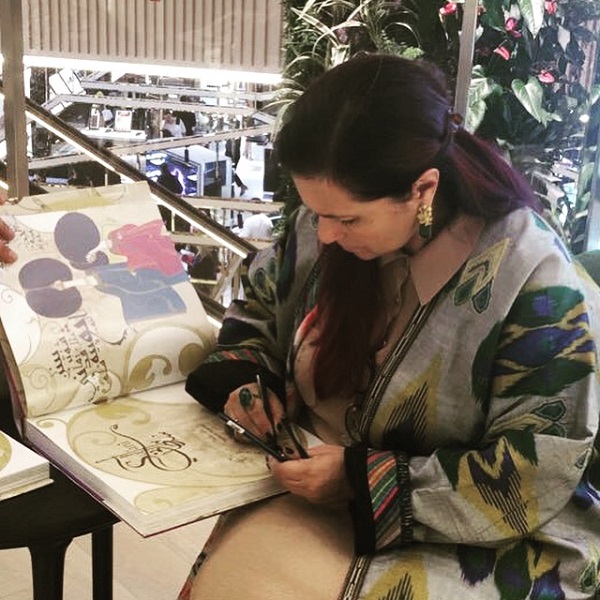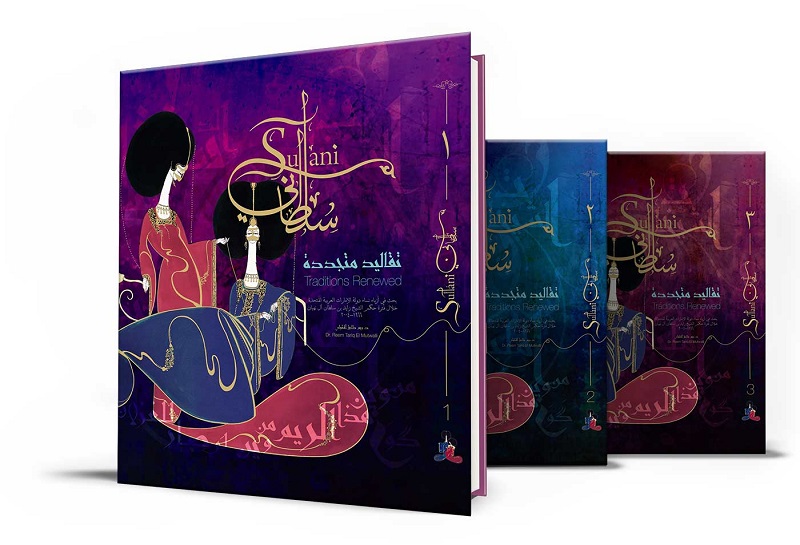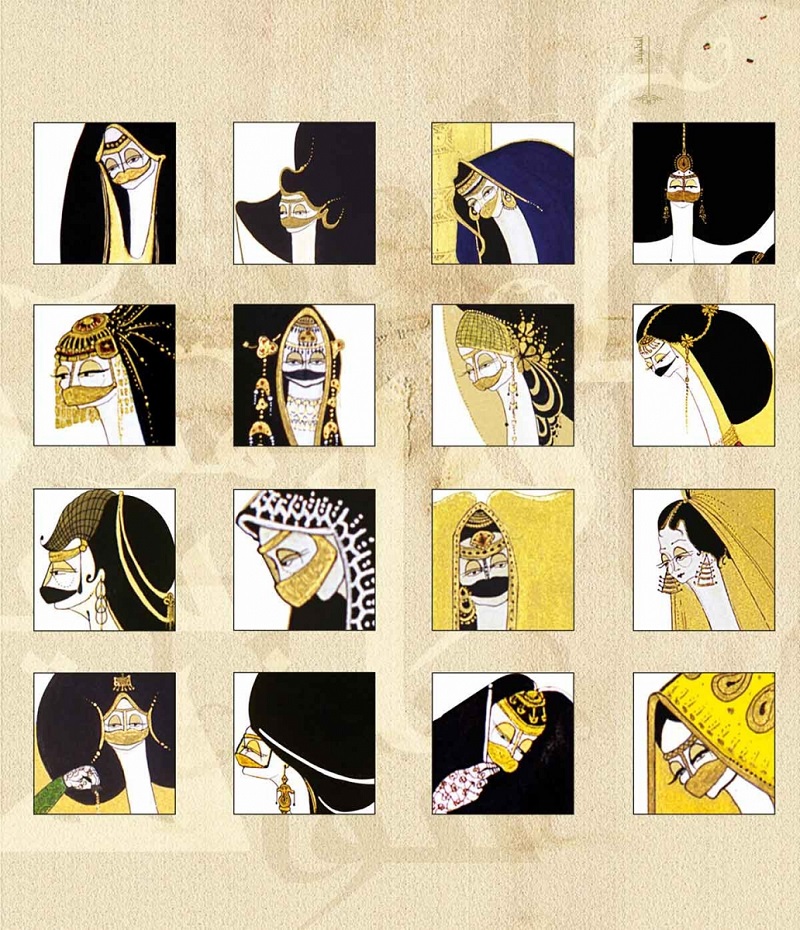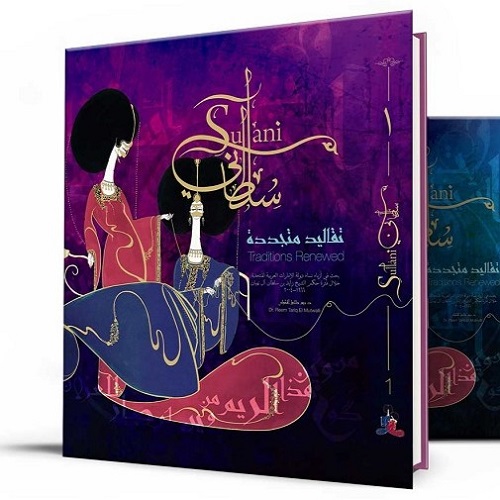SULTANI
Sulṭānī: (Arabic: sultān: king). In the UAE the term denotes to silk satin fabric in multiple vertical striped colours, commonly used for tunics (kanadir) and underpants (sarāwīl). Also refers to book: Sultani, Traditions Renewed, Changes in women’s traditional dress In the United Arab Emirates during the reign of the late Shaykh Zāyid Bin Sultan āl Nahyān, 1966-2004, By Dr. Reem Tariq
Ṭariq: (Arabic; Synonym: tulle_bi_talli
Tūlle_bi_tallī: (French: Tulle – a city in France where fine material for veil was first made; Turkish: tel – wire; Synonym: tariq; talli; badla; khus_dozi ), series of small metal knots made on a woven net ground as embellishment. The term is commonly used in the North African Arab region specifically in Egypt.
; talli; badla; khus_dozi ), series of small metal knots made on a woven net ground as embellishment. The term is commonly used in the Levant Arab region specifically in Lebanon.
El Mutwalli (2011). Traditions Renewed
Changes in women’s traditional dress in the United Arab Emirates during the reign of Shaykh Zãyid bin Sultãn Ãl Nahyãn 1966-2004
Author: Dr Reem
Tariq
Ṭariq: (Arabic; Synonym: tulle_bi_talli
Tūlle_bi_tallī: (French: Tulle – a city in France where fine material for veil was first made; Turkish: tel – wire; Synonym: tariq; talli; badla; khus_dozi ), series of small metal knots made on a woven net ground as embellishment. The term is commonly used in the North African Arab region specifically in Egypt.
; talli; badla; khus_dozi ), series of small metal knots made on a woven net ground as embellishment. The term is commonly used in the Levant Arab region specifically in Lebanon.
El Mutwalli
Photographers: Zayed El Mutwalli and Arif Ãl Banãyī
Artists: Hayv Kahraman, Fatima Lootah, Mohammed Mandi
Published: by Author, Second Edition 2015
Format & layout
Two volumes @ 320 x 320 x 42 mm (12.6" x 12.6" x 1.65”)
Hardcover
620 pages over two volumes
ISBN 978-9953-467-39-9
English and Arabic

Photos, Illustrations & Diagrams
This set of two volumes is richly illustrated and decorated with work by three different artists and includes illustrations, calligraphy, and graphic design which enhances the written content of the book and elevates it, making this much more than a mere book but rather a work of art in its own right. The books are heavy, not only indicating their quality but signifying the weight of the knowledge contained inside the pages.
The book contains many hundreds of images, some posed images of the garments being described, some unique and rare images dating from the early years of the UAE, and some close-up images of details, embellishments, and decorations described in the book.

Introduction
“The book documents significant aspects of the UAE’s history and its most recent development and describes the traditional clothing of UAE women as it has evolved over the past five decades. And sets these changes in its historical, cultural, social, economic, political, and ethnic context. She traces the impact of oil wealth, urbanisation, access to the global market, and the pressures of globalisation on clothing and the conservative Arab Islamic society.”
Philip Kennedy, Vice Provost, Institute Public Programming NYU Abu Dhabi April 21, 2015
The book is based on Dr Reem’s PhD thesis of the same name, presented to London University SOAS in 2007. Her research was conducted between 1997 and 2004.

Content
Volume One consists of eight chapters, each with several sub-topics. These chapters focus on the context and a range of factors that influenced UAE dress development, such as regional and political influences, religion and traditions such as concealment and tribal hierarchy. It also covers more practical influences such as dressmaking methods, availability of textiles, and the range of crafts and embellishments in UAE tradition.
Volume Two focuses on the garments themselves and consists of seven chapters each discussing one form of clothing such as facemasks, head covers, body covers, dresses, underwear, and footwear. The last chapter discusses the storage and maintenance of traditional clothes. This volume also includes a comprehensive bibliography and a list of Arabic terminology related to dress. The last section contains an image showcase of dress items from the
Sultani
Sulṭānī: (Arabic: sultān: king). In the UAE the term denotes to silk satin fabric in multiple vertical striped colours, commonly used for tunics (kanadir) and underpants (sarāwīl). Also refers to book: Sultani, Traditions Renewed, Changes in women’s traditional dress In the United Arab Emirates during the reign of the late Shaykh Zāyid Bin Sultan āl Nahyān, 1966-2004, By Dr. Reem Tariq
Ṭariq: (Arabic; Synonym: tulle_bi_talli
Tūlle_bi_tallī: (French: Tulle – a city in France where fine material for veil was first made; Turkish: tel – wire; Synonym: tariq; talli; badla; khus_dozi ), series of small metal knots made on a woven net ground as embellishment. The term is commonly used in the North African Arab region specifically in Egypt.
; talli; badla; khus_dozi ), series of small metal knots made on a woven net ground as embellishment. The term is commonly used in the Levant Arab region specifically in Lebanon.
El Mutwalli (2011). collection being modelled

Conclusion
Unlike most other books about textile and dress heritage, this book is not based on museum collections or archaeological discoveries but rather on personal experience, interviews and conversations with people who have a living memory of this subject matter, and on the author’s collection of UAE traditional clothes which she obtained from the original owners and wearers.
Another unique resource the author had access to is private collections of rare photographs. Women in this region were rarely photographed, and if they were, their faces were covered and their identities obscured. Any photographs that do exist were taken in great privacy and on special occasions by trusted female photographers and the original film was retained by the family. These images provided great insight into not only the clothes but the circumstances in which it was worn.
Interviewees included female members of the ruling family, other prominent women from both the elite and other layers of society, professional women in the tailoring and dressmaking industry, as well as professional men mainly from India, Pakistan, and the Philippines who were involved in the tailoring and textile industry.
This is just a small insight into the exclusivity of the content of this publication. Combined with the artistic layout and the fact that each page contains the same information in both English and Arabic, makes this not only an important resource on dress heritage but a unique and valuable contribution to the heritage of the UAE.
Dr Reem is passionate about documenting not only dress heritage but the context and the human aspects that influence the way it was worn. She believes in living history and in recording the intangible values of dress and adornment. This book is a testament to her passion and dedication.
***
The
Sultani
Sulṭānī: (Arabic: sultān: king). In the UAE the term denotes to silk satin fabric in multiple vertical striped colours, commonly used for tunics (kanadir) and underpants (sarāwīl). Also refers to book: Sultani, Traditions Renewed, Changes in women’s traditional dress In the United Arab Emirates during the reign of the late Shaykh Zāyid Bin Sultan āl Nahyān, 1966-2004, By Dr. Reem Tariq
Ṭariq: (Arabic; Synonym: tulle_bi_talli
Tūlle_bi_tallī: (French: Tulle – a city in France where fine material for veil was first made; Turkish: tel – wire; Synonym: tariq; talli; badla; khus_dozi ), series of small metal knots made on a woven net ground as embellishment. The term is commonly used in the North African Arab region specifically in Egypt.
; talli; badla; khus_dozi ), series of small metal knots made on a woven net ground as embellishment. The term is commonly used in the Levant Arab region specifically in Lebanon.
El Mutwalli (2011). Book is available exclusively from the author and can be ordered from
The Zay
Zay: (Arabic: costume, Pl. azyaā’), a set of clothes in a style typical of a particular country or historical period. Initiative website.
To view interviews with Dr Reem or hear her talk about the book, visit the
Sultani
Sulṭānī: (Arabic: sultān: king). In the UAE the term denotes to silk satin fabric in multiple vertical striped colours, commonly used for tunics (kanadir) and underpants (sarāwīl). Also refers to book: Sultani, Traditions Renewed, Changes in women’s traditional dress In the United Arab Emirates during the reign of the late Shaykh Zāyid Bin Sultan āl Nahyān, 1966-2004, By Dr. Reem Tariq
Ṭariq: (Arabic; Synonym: tulle_bi_talli
Tūlle_bi_tallī: (French: Tulle – a city in France where fine material for veil was first made; Turkish: tel – wire; Synonym: tariq; talli; badla; khus_dozi ), series of small metal knots made on a woven net ground as embellishment. The term is commonly used in the North African Arab region specifically in Egypt.
; talli; badla; khus_dozi ), series of small metal knots made on a woven net ground as embellishment. The term is commonly used in the Levant Arab region specifically in Lebanon.
El Mutwalli (2011). website







